|
Aeolian Islands
|
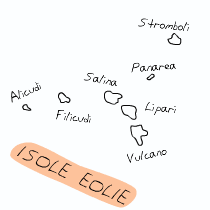 Spectacular
sceneries, sandy beaches, colours, exhilarating flavours and fragrances
have always made the Aeolian islands a much sought after place by the
ancient gods. Today, although the Islands are symbol of tourism, they
still respect the past, fashionable but at the same time a place where
one can listen to or be culled by the sound of the sea or the rustling
of the breeze among the sails and the trees. There are seven Islands
that make up the archipelago: Lipari, Vulcano, Salina, Panarea,
Stromboli, Filicudi and Alicudi. They extend over an area of
approximately 45 miles from East to West and 30 miles from North to
South; they are all of volcanic origin, some with craters still in
activity. Spectacular
sceneries, sandy beaches, colours, exhilarating flavours and fragrances
have always made the Aeolian islands a much sought after place by the
ancient gods. Today, although the Islands are symbol of tourism, they
still respect the past, fashionable but at the same time a place where
one can listen to or be culled by the sound of the sea or the rustling
of the breeze among the sails and the trees. There are seven Islands
that make up the archipelago: Lipari, Vulcano, Salina, Panarea,
Stromboli, Filicudi and Alicudi. They extend over an area of
approximately 45 miles from East to West and 30 miles from North to
South; they are all of volcanic origin, some with craters still in
activity.
|
|
Lipari
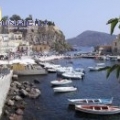 The main island, certainly the richest in history, inhabited since the Palaeolithic Age. The most striking feature of the ancient remains is certainly the castle, dating back to the VI century and situated on the ancient acropolis. Today, the castle houses the "Aeolian Archeological Museum" which relates the History of the Islands from prehistoric times to the Middle Ages. Characteristic of the Island are: the pumice-stone quarries of Porticello, which render the beach and surrounding waters a peculiar white colour; the Faraglioni to the south off Vulcano; the lively square of Marina Corta; Sottomonastero, or Marina Lunga, a landing place with a quay reserved for boats in transit. The tourist port of "Pignataro" is situated to the extreme north of the inlet. It is protected by an outer quay with bollards and rings. The main island, certainly the richest in history, inhabited since the Palaeolithic Age. The most striking feature of the ancient remains is certainly the castle, dating back to the VI century and situated on the ancient acropolis. Today, the castle houses the "Aeolian Archeological Museum" which relates the History of the Islands from prehistoric times to the Middle Ages. Characteristic of the Island are: the pumice-stone quarries of Porticello, which render the beach and surrounding waters a peculiar white colour; the Faraglioni to the south off Vulcano; the lively square of Marina Corta; Sottomonastero, or Marina Lunga, a landing place with a quay reserved for boats in transit. The tourist port of "Pignataro" is situated to the extreme north of the inlet. It is protected by an outer quay with bollards and rings.
|
|
Vulcano
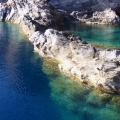 The island of thermal springs and mud-bathing, a destination of sport enthusiasts who can appreciate and enjoy the beauty of its waters together with that of the volcano, from which there are breathtaking sights, for example, the view of the surrounding islands and the isthmus connecting Vulcano to Vulcanello. The island offers a variety of sceneries but access to the most beautiful spots are to be reached by sea: La Grotta del Cavallo, the pool of Venere, the beaches to the South and the numerous caves to the West. The island of thermal springs and mud-bathing, a destination of sport enthusiasts who can appreciate and enjoy the beauty of its waters together with that of the volcano, from which there are breathtaking sights, for example, the view of the surrounding islands and the isthmus connecting Vulcano to Vulcanello. The island offers a variety of sceneries but access to the most beautiful spots are to be reached by sea: La Grotta del Cavallo, the pool of Venere, the beaches to the South and the numerous caves to the West.
|
|
Stromboli
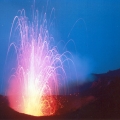 Stromboli is one of the two active volcanoes in Italy. The marine scenery of the island is full of grottos, among which "Eolo Grotto". Two characteristic features of the island are: "Strombolicchio" where the cliffs to the north rise steeply to 56 meters above the Tyrrhenian Sea and "Sciara del Fuoco" where the vertical precipice descends down to the sea bringing with it its incandescent material. The latter is better seen by night and can be reached only by sea. Situated around the sandy point "Lena", there is a small village which can be reached by landing at Ficogrande or San Vincenzo which form a single dwelling place. On the opposite side of the island: Ginostra, which has electricity for very short time. Stromboli is one of the two active volcanoes in Italy. The marine scenery of the island is full of grottos, among which "Eolo Grotto". Two characteristic features of the island are: "Strombolicchio" where the cliffs to the north rise steeply to 56 meters above the Tyrrhenian Sea and "Sciara del Fuoco" where the vertical precipice descends down to the sea bringing with it its incandescent material. The latter is better seen by night and can be reached only by sea. Situated around the sandy point "Lena", there is a small village which can be reached by landing at Ficogrande or San Vincenzo which form a single dwelling place. On the opposite side of the island: Ginostra, which has electricity for very short time.
|
|
Salina
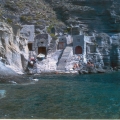 This Island with its steep rugged coastline is the most unspoilt of the Islands. It is formed by two extinct volcanoes: "Monte Fossa delle Felci and "Monte dei Porri" which give it an aspect for which the ancient name of Island was derived: "Dydime" or rather twins. Salina is named after the salt-works to the South-east, beyond cape "Lingua". The island is formed of numerous small natural bays, among which, Pollara, with its beaches and deserted fishermen's cottages, very picturesque at sunset; Rinella with its black-coloured grottos , which has been transformed into a small port. The very first tourist port of the Aeolian islands was realized at Santa Marina Salina. This Island with its steep rugged coastline is the most unspoilt of the Islands. It is formed by two extinct volcanoes: "Monte Fossa delle Felci and "Monte dei Porri" which give it an aspect for which the ancient name of Island was derived: "Dydime" or rather twins. Salina is named after the salt-works to the South-east, beyond cape "Lingua". The island is formed of numerous small natural bays, among which, Pollara, with its beaches and deserted fishermen's cottages, very picturesque at sunset; Rinella with its black-coloured grottos , which has been transformed into a small port. The very first tourist port of the Aeolian islands was realized at Santa Marina Salina.
|
|
Panarea
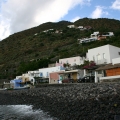 Limpid waters, craggy cliffs and fascinating seabeds make Panarea a much sought after place for sub aquatic sports. Young and lively tourists are attracted not only by the beauty of Panarea but by the vivacious nightlife. By day one can visit the Bronze Age village located on the promontory of cape Milazzese where the cliffs form a splendid calanque: Cala Junco, which is one of the most beautiful places of all the Islands. Limpid waters, craggy cliffs and fascinating seabeds make Panarea a much sought after place for sub aquatic sports. Young and lively tourists are attracted not only by the beauty of Panarea but by the vivacious nightlife. By day one can visit the Bronze Age village located on the promontory of cape Milazzese where the cliffs form a splendid calanque: Cala Junco, which is one of the most beautiful places of all the Islands.
|
|
Alicudi e Filicudi
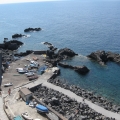 Ideal places for those seeking pure nature and calm. Its ancient name was Phoenicusa since it is covered with ferns. Filicudi can be reached from the port to the East or from the village of Pecorini which lies to the south and where there is a landing-stage. The most beautiful parts can be discovered only by sailing: the faraglione "La canna", the small island of "Montenassari" and the "Giafante", the rocky cliffs of good fortune and the enchanting "Bue Marino" grotto. Alicudi is quieter still and not so easily accessible and for which it is usually excluded from the itineraries. Mooring has recently been facilitated by the landing-place of Palomba. The contrast between land and sea is really fascinating. Ideal places for those seeking pure nature and calm. Its ancient name was Phoenicusa since it is covered with ferns. Filicudi can be reached from the port to the East or from the village of Pecorini which lies to the south and where there is a landing-stage. The most beautiful parts can be discovered only by sailing: the faraglione "La canna", the small island of "Montenassari" and the "Giafante", the rocky cliffs of good fortune and the enchanting "Bue Marino" grotto. Alicudi is quieter still and not so easily accessible and for which it is usually excluded from the itineraries. Mooring has recently been facilitated by the landing-place of Palomba. The contrast between land and sea is really fascinating.
|
ROUTES
|
Route 1 (3 days)
Portorosa - Panarea - Lipari - Vulcano –
Portorosa

Departure from Portorosa – Panarea : Cala Junco, Lisca Bianca, Basiluzzo
- Lipari, trips by land:visit to the Aeolian archaeological Museum,
overnight stay in Pignataro; trips by sea: Spiagge Bianche (white
beaches), Faraglioni- Vulcano, trips by land: hot muds and underwater
fumaroles; visit to the crater's peak (the climb takes about 30') –
Trips by sea: black sands, Piscina di Venere and Grotta del cavallo –
Return to Portorosa. |
Route 2 (7 days)
Portorosa - Vulcano - Lipari - Panarea -
Salina - Filicudi - Lipari - Vulcano – Portorosa
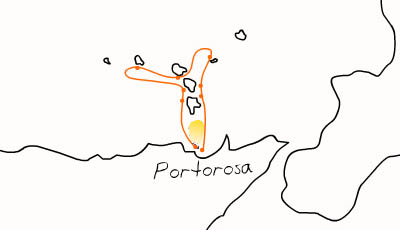
Portorosa - Vulcano - Lipari - Panarea - Salina - Filicudi - Lipari -
Vulcano – Portorosa Departure from Portorosa - Vulcano: trips by land,
hot muds and underwater fumaroles; visit to the crater's peak (the climb
takes about 30') – Trips by sea: Faraglioni – Lipari, trips by land:
visit to the Aeolian archaeological Museum, overnight stay in Pignataro,
trips by sea: Spiagge Bianche (white beaches) - Panarea: Cala Junco,
Lisca Bianca, Basiluzzo – Salina: S. Marina and overnight stay by the
tourist port , Malfa, Pollara -Filicudi, trips by sea: La canna, Grotta
del bue marino, Pecorini - Lipari, overnight stay in Pignataro,
Faraglioni - Vulcano, trips by sea: black sands, Piscina di Venere and
Grotta del cavallo – Return to Portorosa.Portorosa - Vulcano - Lipari -
Panarea - Salina - Filicudi - Lipari - Vulcano – Portorosa Departure
from Portorosa - Vulcano: trips by land, hot muds and underwater
fumaroles; visit to the crater's peak (the climb takes about 30') –
Trips by sea: Faraglioni – Lipari, trips by land: visit to the Aeolian
archaeological Museum, overnight stay in Pignataro, trips by sea:
Spiagge Bianche (white beaches) - Panarea: Cala Junco, Lisca Bianca,
Basiluzzo – Salina: S. Marina and overnight stay by the tourist port ,
Malfa, Pollara -Filicudi, trips by sea: La canna, Grotta del bue marino,
Pecorini - Lipari, overnight stay in Pignataro, Faraglioni - Vulcano,
trips by sea: black sands, Piscina di Venere and Grotta del cavallo –
Return to Portorosa.
|
|
Route 3 (7 days)
Portorosa - Vulcano - Lipari - Panarea -
Stromboli - Salina - Lipari - Vulcano – Portorosa
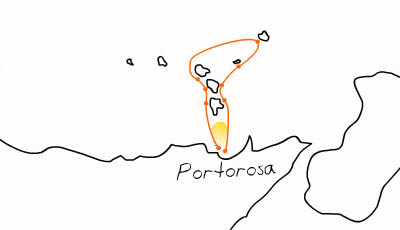
Departure from Portorosa - Vulcano: trips by land, hot muds and
underwater fumaroles; visit to the crater's peak (the climb takes about
30') – Trips by sea:Faraglioni – Lipari, trips by land:visit to the
Aeolian archaeological Museum, overnight stay in Pignataro, trips by sea:
Spiagge Bianche (white beaches) - Panarea : Cala Junco, Lisca Bianca,
Basiluzzo –Stromboli, trip by land:visit to the crater (the climb takes
about 4 hours); trip by sea: Ginostra, Strombolicchio - Salina :
S.Marina, Malfa, Pollara - Lipari, trip by sea: Faraglioni - Vulcano,
trips by sea: black sands, Piscina di Venere and Grotta del cavallo –
Return to Portorosa. |
Route 4 (15 days)
Portorosa - Capo Milazzo - Stromboli -
Panarea - Salina - Filicudi - Alicudi - Lipari - Vulcano - Capo
D'Orlando - Capo Calavà
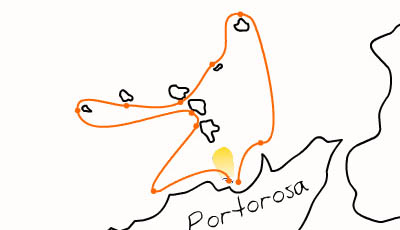
Departure from Portorosa – Capo Milazzo – Stromboli, trip by land: visit
to the crater (the climb takes about 4 hours); trip by sea: Ginostra,
Strombolicchio - Panarea : Cala Junco, Lisca Bianca, Basiluzzo - Salina
: S.Marina, Malfa, Pollara - Filicudi, trips by sea: La canna, Grotta
del bue marino, Pecorini – Alicudi – Lipari, trips by land:visit to the
Aeolian archaeological Museum, overnight stay in Pignataro, trips by sea:
Spiagge Bianche (white beaches), Faraglioni - Vulcano, trips by sea:
black sands, Piscina di Venere and Grotta del cavallo – Capo d'Orlando –
Capo Calavà - Return to Portorosa.
|
|
Route 5 (15 Days)
Portorosa - Vulcano - Lipari - Salina -
Filicudi - Alicudi - Ustica - Favignana - Marettimo - Levanzo - San Vito
Lo Capo - Palermo - Cefalù – Portorosa
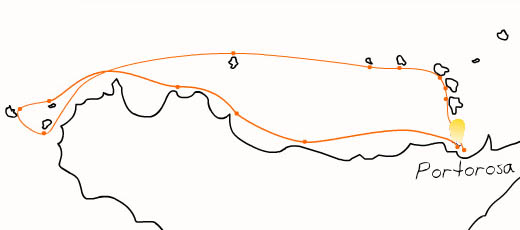
Departure from Portorosa – Capo Milazzo – Stromboli, trip by land: visit
to the crater (the climb takes about 4 hours); trip by sea: Ginostra,
Strombolicchio - Panarea: Cala Junco, Lisca Bianca, Basiluzzo - Salina :
S. Marina, Malfa, Pollara - Filicudi, trips by sea: La canna, Grotta del
bue marino, Pecorini – Alicudi – Lipari, trips by land:visit to the
Aeolian archaeological Museum, overnight stay in Pignataro, trips by sea:
Spiagge Bianche (white beaches), Faraglioni - Vulcano, trips by sea:
black sands, Piscina di Venere and Grotta del cavallo – Capo d'Orlando –
Capo Calavà - Return to Portorosa.
|
Route 6 (15 days)
Portorosa - Ustica - Egadi - Pantelleria - Siracusa - Taormina (Giardini
Naxos) - Messina - Capo Milazzo – Portorosa.
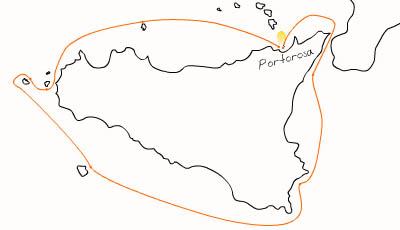
Departure from Portorosa – Ustica – Favignana: Villa Florio – Marittimo,
Scalo Vecchio – Levanzo. The archipelago of the Aegadean Islands is a
marine natural reserve. The islets of Formica and of Maraone.
Pantelleria – Siracusa – Giardini Naxos: visit to the unforgettable
Taormina – Messina – Capo Milazzo – Portorosa. |
Route 7 (15 Days)
Portorosa - Milazzo – Messina - Taormina (Giardini Naxos) - Catania - Siracusa –
Malta - Catania - Reggio Calabria - Portorosa
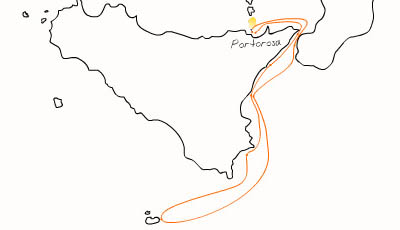
Departure from Portorosa – Capo Milazzo – Messina: crossing of the straits and
stay overnight on board by the Marina – Giardini Naxos: visit to Taormina –
Catania : visit of the town by the volcano Etna – Siracusa: to see Ortigia –
Malta – Catania – Reggio Calabria: visit to the museum – Portorosa.
|